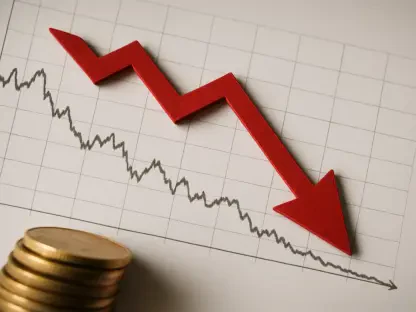As the global economy stumbles through a challenging period marked by sluggish growth and mounting uncertainties, commodity markets are bearing the brunt of the downturn with significant implications for industries worldwide. This economic slowdown, characterized by reduced industrial activity and faltering consumer demand, has led to a sharp decline in the need for essential resources such as energy and industrial metals, pushing prices down and straining producers. Forecasts indicate that this troubling trend may persist into the coming years, casting a shadow over markets from oil to copper. Yet, amidst this gloom, certain sectors like renewable energy and electric vehicles are showing resilience, driving demand for specific materials despite the broader decline. This intricate balance between a weakening economy and pockets of growth creates a volatile landscape where outcomes vary widely across industries. This article delves into the multifaceted effects of the slowdown on commodity markets, exploring how reduced demand, emerging opportunities in green technologies, and broader geopolitical factors are reshaping the sector. By examining the challenges faced by traditional producers and the potential for innovation in sustainable areas, a clearer picture emerges of who stands to lose and who might gain in this turbulent environment. The analysis aims to provide a comprehensive understanding of the forces at play, offering insights into navigating the complexities of a market caught between short-term pressures and long-term transformations.
Economic Downturn Pressures Commodity Demand
The core of the current crisis in commodity markets lies in the direct impact of a global economic slowdown on demand for fundamental resources. Major economies like the U.S., Europe, and China are experiencing significant reductions in industrial activity, manufacturing output, and construction projects, all of which are primary consumers of energy and metals. Electricity consumption in regions such as the European Union has plummeted to historic lows, reflecting the depth of the downturn. Similarly, copper—a metal often seen as a barometer of economic health—has witnessed sliding prices due to weakened manufacturing sectors. Projections from reputable institutions like the World Bank suggest that prices for metals including aluminum, iron ore, and zinc could face steep declines through 2026, signaling a prolonged period of hardship for producers. This cascading effect touches every corner of the supply chain, from mining operations to refineries, as reduced demand translates into lower revenues and tighter margins. The broader implications are evident in how these trends disrupt not just commodity markets but also the economic stability of nations reliant on resource exports.
Beyond the immediate impact on producers, the slowdown reverberates through related sectors such as transportation and consumer goods, where fluctuating commodity costs play a critical role. Lower demand often leads to depressed prices, which can influence everything from fuel costs at gas stations to the price of everyday household items. However, this is not merely a fleeting issue—analysts caution that if economic recovery falters, the slump in commodity demand could intensify, creating a vicious cycle of reduced investment and output. The challenge for stakeholders lies in anticipating how long these conditions will persist and preparing for a market environment where global activity remains subdued. Commodity markets find themselves squeezed by these overarching economic forces, with little room to maneuver unless significant stimulus or recovery emerges on the horizon.
Resilience in Green Technology Sectors
Amidst the pervasive decline in commodity markets, a notable countertrend is emerging from the push toward sustainability, which continues to bolster demand for specific materials. Commodities like lithium, nickel, and cobalt, essential for electric vehicle batteries and renewable energy technologies, are experiencing sustained interest despite the economic headwinds. Industry projections indicate that the need for these “green” materials could grow exponentially over the next decade, driven by global commitments to reduce carbon emissions and transition to cleaner energy sources. Companies involved in solar panel production and wind turbine manufacturing are finding steady demand, setting themselves apart from the broader market slump. This trend underscores a structural shift in the global economy, where environmental priorities are beginning to reshape resource consumption patterns even in tough times.
However, the economic slowdown imposes constraints on how far this positive momentum can carry the green commodity sector in the immediate term. Tightening budgets and reduced consumer spending power could limit investments in renewable projects, tempering the growth potential of these materials. While the long-term outlook remains promising, with policies and innovations likely to fuel further expansion, the current climate of economic uncertainty might drag down prices across all commodities, including those tied to sustainability. This creates a dynamic tension between short-term cyclical challenges and enduring structural shifts, leaving market participants to navigate a landscape where gains in one area are often offset by losses in another. The resilience of green sectors offers a glimpse of hope, but it is not immune to the broader forces at play in a struggling global economy.
Diverging Fortunes Among Market Players
The economic slowdown has created a stark divide within commodity markets, separating those who are struggling from those positioned to weather the storm or even prosper. Producers heavily reliant on industrial metals and traditional energy sources, such as oil and coal, are facing severe headwinds as demand evaporates. Major mining companies are scaling back operations, and shale oil producers in the U.S. are bracing for further cuts as projections suggest oil prices could plummet to unsustainable levels by 2026. These challenges highlight the vulnerability of sectors tied to cyclical economic patterns, where a downturn can quickly erode profitability and force difficult decisions about production and investment. The ripple effects extend to communities and economies dependent on these industries, amplifying the stakes of the current crisis.
In contrast, certain segments of the market are finding refuge and opportunity amidst the turmoil, illustrating the importance of adaptability. Gold producers, for instance, are benefiting from a flight to safety as investors seek stable assets during periods of uncertainty. Similarly, companies focused on materials critical to the green transition, such as lithium for battery production, are maintaining stability thanks to consistent demand from emerging technologies. Renewable energy firms are also carving out a resilient niche, capitalizing on global trends toward decarbonization even as other sectors falter. This disparity underscores a critical lesson for market players: alignment with long-term shifts, particularly in sustainability, can provide a buffer against short-term economic shocks. The ability to pivot or diversify becomes a defining factor in determining who emerges stronger from this challenging period.
Wider Implications for Trade and Governance
The repercussions of the slowdown in commodity markets extend well beyond price fluctuations and corporate balance sheets, influencing global trade dynamics and policy frameworks. Supply chains, particularly in regions like Asia, are under strain as trade tensions and tariffs introduce additional layers of uncertainty, disrupting the flow of raw materials. Commodity-exporting nations are confronting shrinking revenues, which complicates fiscal planning and forces a delicate balance between immediate budgetary needs and long-term industry sustainability. Governments are pressed to reassess policies, such as royalty rates and subsidies, to support struggling sectors without undermining future growth. These shifts in trade and policy reflect the interconnected nature of global markets, where a downturn in one area can trigger widespread adjustments.
Adding to the complexity are geopolitical risks and the potential for supply disruptions, which could upend even the most carefully laid plans. While declining commodity prices generally ease inflationary pressures in many economies, unexpected shocks—such as sudden spikes in natural gas costs—could reverse these gains and create new economic challenges. Industries like mining and energy are compelled to prioritize cost-cutting and efficiency to survive the lean times, often accelerating innovations in operations. For businesses, investors, and policymakers, staying agile is paramount, as is maintaining a close watch on both economic indicators and international developments. The broader landscape of commodity markets is thus shaped not only by demand and supply but also by a web of external forces that demand strategic foresight and flexibility to navigate successfully.
Strategic Pathways for Market Adaptation
Reflecting on the widespread impact of the global economic slowdown, it becomes evident that commodity markets have entered a period of profound transformation, marked by both significant challenges and unique opportunities. Producers of traditional resources grapple with plummeting demand and shrinking margins, while those tied to green technologies find pockets of growth amidst the turmoil. The divide between winners and losers grows sharper, shaped by the ability to adapt to long-term trends like sustainability and decarbonization. Geopolitical tensions and policy shifts further complicate the landscape, adding layers of uncertainty that test the resilience of industries and nations alike.
Looking ahead, the focus must shift toward actionable strategies to mitigate risks and capitalize on emerging possibilities. Companies are encouraged to prioritize supply chain security and invest in vertical integration, especially for critical minerals essential to future technologies. Policymakers should consider targeted support for vulnerable sectors while fostering innovation in recycling and efficiency to reduce dependency on volatile markets. Investors might find value in undervalued assets tied to the green transition, balancing immediate risks with long-term potential. Monitoring key indicators, such as manufacturing indices and central bank policies, will be crucial for anticipating shifts in demand. Ultimately, the path forward lies in building a more adaptive and sustainable commodity market, one capable of withstanding economic downturns through strategic planning and alignment with global priorities.









